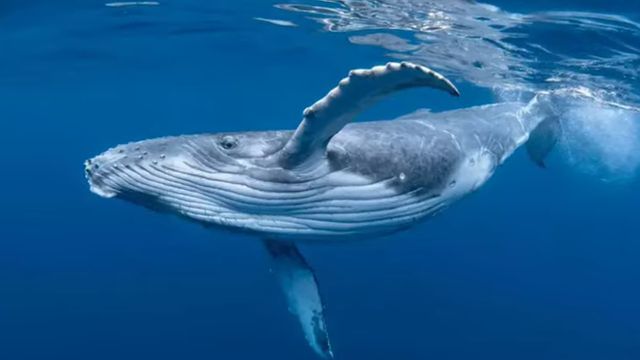Blue whales, the largest creatures to ever live on Earth, have long been known for their iconic, low-frequency songs that echo across oceans. These majestic giants’ calls were once heard over vast distances, allowing them to communicate, navigate, and even find mates. But in recent years, a troubling trend has emerged: blue whales are going silent. This sudden disappearance of their haunting melodies is raising alarm bells among marine scientists. It’s not just about the whales; it’s about the health of our oceans—and ultimately, our planet.
For over six years, researchers have been monitoring blue whale vocalizations in the waters off California. What they found is alarming. The frequency of blue whale songs has dropped by nearly 40%. The reason? A complex web of environmental factors, chief among them marine heatwaves and their devastating effect on the whales’ food source: krill.
The Cause Behind the Silence: Marine Heatwaves and Food Scarcity
The main culprit behind the silence of blue whales is marine heatwaves. These heatwaves, driven by rising ocean temperatures, have caused massive disruptions to marine ecosystems. The increase in temperature has fueled toxic algae blooms and decreased the availability of krill—blue whales’ primary food source. Without krill, blue whales are starving.
Imagine trying to sing while struggling to find food. That’s what researchers like Dr. John Ryan from the Monterey Bay Aquarium Research Institute suggest is happening to these incredible creatures. Without enough food to sustain their massive bodies, singing—once a vital part of their existence—simply becomes impossible.
The marine heatwave that began in 2013, known as “The Blob,” lasted for several years. It caused ocean temperatures to rise by over 4.5°F in some areas, wreaking havoc on the local marine life. As krill populations dwindled, blue whales were left with little choice but to stop singing and focus all their energy on survival.
Why Whale Songs Matter: The Role of Communication
Whale songs are not just beautiful sounds; they’re essential for the blue whale’s survival. These vocalizations help whales communicate with each other over vast distances, locate food, and even find mates. Without their songs, blue whales become isolated and fragmented. This isolation hinders their ability to reproduce and makes them more vulnerable to extinction.

In a way, the loss of their songs mirrors the loss of their social structure. It’s not just a physical silence—it’s a collapse of their social networks, which could have cascading effects on their populations. Without this vital communication tool, blue whales are at risk of becoming disconnected from one another, which makes it harder for them to maintain the social bonds that are crucial for their survival.
The Bigger Picture: Blue Whales and Ocean Health
Blue whales don’t just impact their own species; they play a crucial role in maintaining the health of our oceans. These enormous creatures feed on vast quantities of krill, which helps cycle nutrients throughout the ocean. This process is vital for maintaining the plankton populations that absorb carbon and support marine life.
A reduction in blue whale populations means fewer nutrients are cycled back into the ocean. This can lead to a weaker ecosystem, which in turn has direct consequences for ocean health. If blue whale populations continue to decline, the entire oceanic food web could be at risk.
More importantly, fewer blue whales could mean less carbon sequestration, exacerbating climate change. The silence of these creatures is not just an ecological tragedy; it’s a warning about the broader environmental crisis unfolding before us.
The Growing Threat of Climate Change
The decline of blue whale vocalizations isn’t an isolated event. It’s part of a broader pattern of marine life struggling to adapt to a warming planet. Rising ocean temperatures, caused by climate change, are making the seas more hostile to many species. Marine heatwaves, like the one that caused “The Blob,” are becoming more frequent and intense.
As Dr. Kelly Benoit-Bird, a marine biologist at the Monterey Bay Aquarium, explains, the disappearance of krill and the silence of blue whales are symptoms of a larger problem. The ocean is changing rapidly, and these shifts are destabilizing ecosystems that have existed for millennia. If we don’t act quickly to address climate change, we could lose not only blue whales but entire ecosystems that are critical to the health of our planet.
Time to Act: Protecting Blue Whales and Our Oceans
The silence of blue whales is a wake-up call. The challenges they face—marine heatwaves, food scarcity, pollution—are directly linked to human activity. Climate change, driven by the burning of fossil fuels, is exacerbating these problems. To protect blue whales, we must take bold action to combat climate change and preserve the health of our oceans.
The plight of the blue whales is a reminder that our fates are tied to the creatures of the deep. If we don’t take action, the silence of the blue whale could mark the beginning of the end for one of the most iconic species on Earth. We need to act now to protect not just the whales but the oceans that sustain all life on Earth.
| Fact | Information |
|---|---|
| Species | Blue Whale (Balaenoptera musculus) |
| Size | Can grow up to 100 feet in length and weigh up to 200 tons |
| Primary Food Source | Krill, small shrimp-like marine creatures |
| Habitat | Found in all the world’s oceans except the Arctic |
| Conservation Status | Endangered, with an estimated population of 10,000 to 25,000 |
| Main Threats | Climate change, marine heatwaves, noise pollution, food scarcity |
| Scientific Studies | Monterey Bay Aquarium, PLOS study (2025) |
For more information, visit the National Geographic article on the subject.
